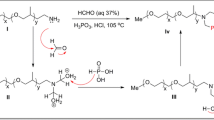Abstract
Three polymers of poly[bis(ethylamino)phosphazene] (PBEAP) containing different amounts of the residual P−Cl moieties, which had been hydrolyzed into P OH in the following sample purification processes, were prepared by substitution of the chlorines on poly(dichlorophosphazene) with ethylamine. Only the polymer which had the highest side-chain content of ethylamino groups (ca. 93°o) had a film-forming ability and a crystalline nature. The hydrolytic degradation of PBEAP in acidic solutions was investigated using the solution viscosity data obtained as a function of standing time. Acetic acid, 0.5 and 1N, pure acetic acid, and 2.2.2-trifluoroethanol were used as solvents. The degradation was composed of random breaking processes along the polymer chain, especially at the-N=P(OH)2-and-N=P(OH)(NHC2H5)-units, and an unzippering-like breaking process which was started at the chain ends produced by the former random breaking. The random breaking caused an abrupt decrease in viscosity at the beginning of the degradation, and on the contrary, the unzippering-like breaking appeared as a gradual decrease in viscosity at the later stages of degradation. The total rate of degradation depended on the concentration of the ethylamino groups.
Similar content being viewed by others
References
H. N. Stokes,Am. Chem. J. 19, 782 (1897).
H. R. Allcock and R. L. Kugel,J. Am. Chem. Soc. 87, 4216 (1965).
H. R. Allcock, R. I. Kugel, and K. J. Valan,Inorg. Chem. 5, 1709 (1966).
H. R. Allcock and R. L. Kugel,Inorg. Chem.,5, 1716 (1966).
H. R. Allcock,Phosphorus-Nitrogen Compounds (Academic Press, New York, 1972).
H. R. Allcock,Chem. Eng. News 63, 222 (1985).
N. S. Schneider, C. R. Desper, and J. J. Beres, inLiquid Crystalline Order in Polymers, A. Blumstem, ed., Academic Press, New York, 1978, pp. 261–297.
H. R. Allcock, inBiodegradable Polymers as Drug Delivery Systems. M. Chasin and R. Langer, eds., (Marcel Dekker, New York, 1990) pp. 163–193.
V. S. Papkov, M. N. Il'ina, D. R. Tur, and G. L. Slonimskii,Polym. Sci. USSR 31. 2509 (1989).
J. Brandrup and E. H. Immergut (eds.)Polymer Hanbook 3rd ed. (Wiley Interscience, New York, 1989).
T. Tanigami, T. Ono, N. Suda, Y. Sakamaki, K. Yamaura and S. Matsuzawa,Macromolecules 22, 1397 (1989).
M. Matsumoto,Kobunshi Kagaku 6, 77 (1949).
Author information
Authors and Affiliations
Rights and permissions
About this article
Cite this article
Tanigami, T., Ohta, H., Orii, R. et al. Degradation of poly[bis(ethylamino)phosphazene] in aqueous solution. J Inorg Organomet Polym 5, 135–153 (1995). https://doi.org/10.1007/BF01058142
Received:
Revised:
Issue Date:
DOI: https://doi.org/10.1007/BF01058142




